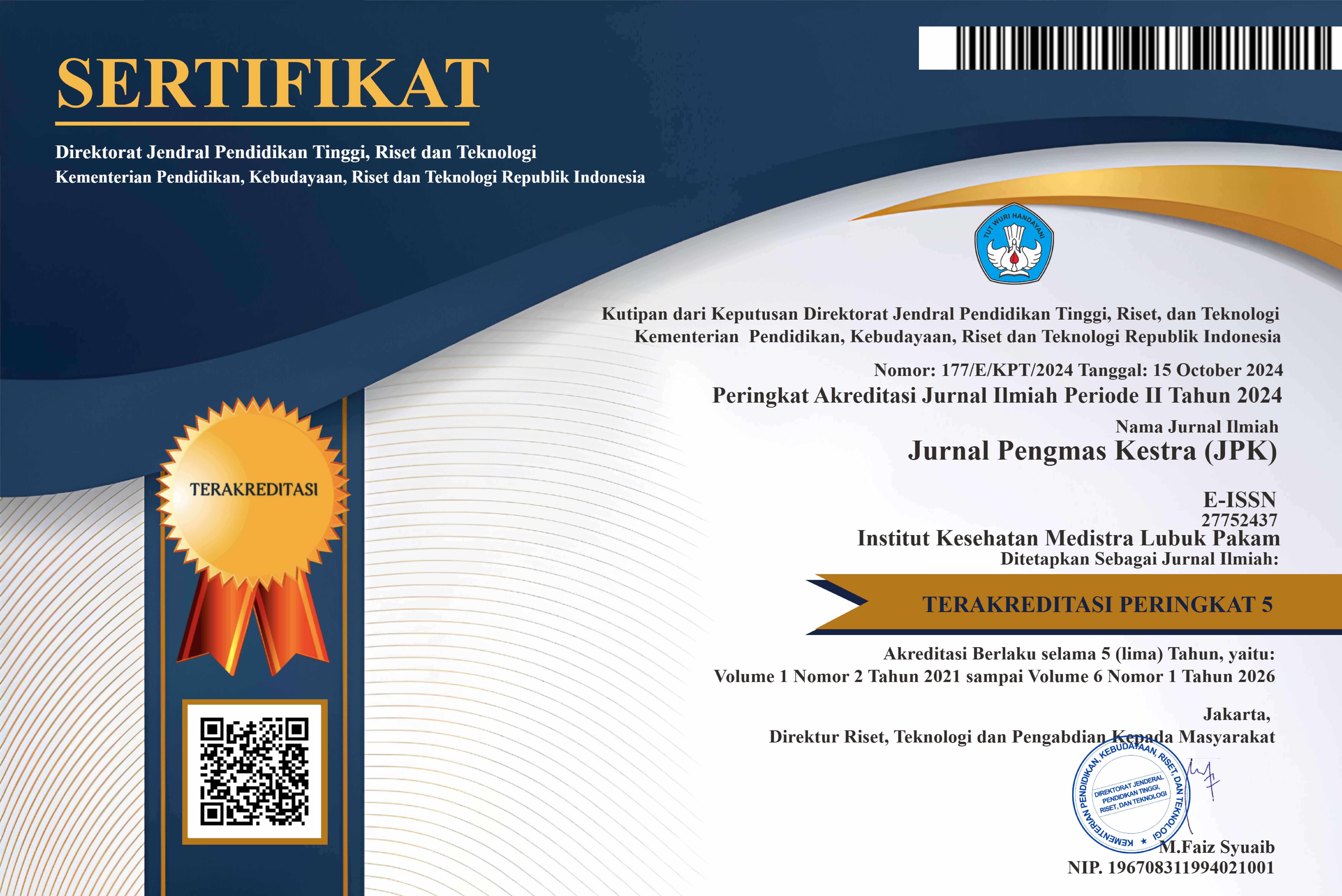Socialization of Low-Salt Diet in Hypertension Patients within Puskesmas Karang Anyar
DOI:
https://doi.org/10.35451/jpk.v3i2.1994Abstract
Hypertension is a type of non-communicable disease and is a health problem that often occurs in society and even around the world. The prevalence of hypertension can increase due to a lack of knowledge about the appropriate diet for hypertension sufferers. A low-salt diet is an appropriate diet for hypertension sufferers to regulate the amount of sodium intake in the body. This service activity aims to increase knowledge about low-salt diets. Method of implementing low salt diet outreach by the community service team using leaflet media. The leaflet was distributed to all activity participants. The number of participants in this PkM activity was 35 people. The implementation carried out by the PkM team consisted of lecturers and students from the Nutrition Study Program, Nursing Study Program, and Midwifery Study Program and collaborated with Karang Anyar Community Health Center partners. Based on the results of the activity, of the 35 participants who attended the service activity, the characteristics of the frequency of participants' blood pressure checks were obtained, the majority of participants had a history of grade II hypertension, 15 people (43.0%). Then there were 12 people in the level II hypertension category (34.2%), followed by the pre-hypertension category with 8 people (22.8%). Based on the results of socialization activities after carrying out before and after evaluations of increasing knowledge for 35 participants, that number was 23 (65.8%). This PkM activity concludes that a lack of knowledge about a low-salt diet is the cause of the high number of hypertension sufferers and a lack of knowledge about the types of food that are recommended and not recommended for hypertension sufferers. So educational programs are needed to increase public understanding about low-salt diets.
References
Ayu, D, Sinaga, F.A, Syahlan, N, Siregar, M.S, Sofi, S, Zega, S, Rusdi, A, Annisa, Dila, A.T. (2022). Faktor-Faktor yang Menyebabkan Hipertensi Di Kelurahan Medan Tenggara. Jurnal Kesehatan Masyarakat, 10(2), 136-147.
Fitri, Y.A.R, Suryana, H.A, Nurbaiti, N. (2020). Pengaruh Penyuluhan Gizi tentang Jajanan Tradisional terhadap Peningkatan Pengetahuan dan Perilaku Jajan Anak Sekolah. Action: Aceh Nutrition Journal, 5(1), 13-18.
Ginting, F. L. (2015). Faktor-Faktor yang Memengaruhi Kejadian Hipertensi pada Lansia Di Wilayah Kerja Puskesmas Silinda Kabupaten Serdang Bedagai Tahun 2013. Universitas Sumatera Utara.
Kementerian Kesehatan RI. (2013). Riset Kesehatan Dasar. Jakarta: Badan Penelitian dan Pengembangan Kesehatan Kementerian Kesehatan Republik Indonesia
Panjaitan, R, Mastiur, S, Ginting M.W, Novita, D, Manurung, J, Manalu, M. (2023). Pengetahuan dan Perilaku Gizi Seimbang terhadap Kejadian Hipertensi Di Desa Sugiharjo Kecamatan batang Kuis. Jurnal Kesehatan Masyarakat & Gizi, 5(2), 247-252.
Purwono, J, Sari, R, Ratnasari, A, Budianto, A. (2020). Pola Konsumsi Garam dengan Kejadian Hipertensi pada Lansia. J Wacana Kesehatan, 5(1), 531-533.
Sjattar, L.E, Majid, A, Arafah, R, Usman, S, Irwan, A.M, Syam, Y. (2021). Pelatihan Diet Rendah Garam pada Keluarga dan Pasien Hipertensi di Puskesmas Batua Makassar. E-DIMAS: Jurnal Pengabdian kepada Masyarakat, 12(3), 498-503.
Yunus, H.M. Kadir S, Lalu, S.A.N. (2023). Hubungan Pola Konsumsi Garam dengan Kejadian Hipertensi pada Lansia di Puskesmas Kota Tengah. Journal Health & Science: Gorontalo Journal Health and Science Community 7(1), 163-171.
Downloads
Published
Issue
Section
License
Copyright (c) 2023 Raini Panjaitan, Sari Desi Esta Ulina Sitepu, Harrys Rambey, Salmi Angraini

This work is licensed under a Creative Commons Attribution 4.0 International License.
Copyright in each article is the property of the Author.




















